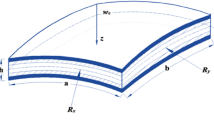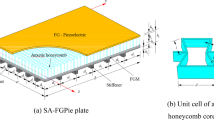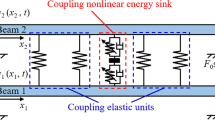The logarithmic decrement of damped vibrations of materials is determined using a theoretical-experimental method. The method is based on measuring the deflection amplitudes of flat cantilever test specimens during their damped vibrations according to the first resonance mode, on the description of internal viscous friction of materials by known models both in linear and nonlinear approximations, on theoretical determination of the aerodynamic constituent of damping, and on a theoretical investigation of damping vibrations of test specimens by employing equations of motion constructed with a corresponding degree of accuracy and pithiness. To determine the vibration decrement of a soft material in tension-compression, sandwich test specimens with a steel core and external layers made of the soft material were used, but in transverse shear — with a core made of the soft material and steel external layers. A considerable effect of external aerodynamic forces on the vibration decrement of the specimens is revealed. Two methods for identification of the parameters of internal damping are proposed on the basis of data of the experimental investigations performed.













Similar content being viewed by others
References
V. N. Paimushin, V. A. Firsov, I. Gyunal, and A. G. Egorov, “Theoretical-experimental method for determining the parameters of damping based on the study of damped flexural vibrations of test specimens. 1. Experimental basis,” Mech. Compos. Mater., 50, No. 2, 127-136 (2014).
ASTM E-756, 2004. Standard Test Method for Measuring Vibration Damping Properties of Materials. Am. Soc. for Testing and Materials.
A. G. Egorov, A. M. Kamalutdinov, A. N. Nuriev, and V. N. Paimushin, “Theoretical-experimental method for determining the parameters of damping based on the study of damped flexural vibrations of test specimens. 2. Aerodynamic Component of Damping,” Mech. Compos. Mater., 50, No. 3, 267-275 (2014).
Ya. G. Panovko, Internal Friction in Vibrations of Elastic Systems [in Russian], Fizmatgiz, Moscow (1960).
G. S. Pisarenko, A. P. Yakovlev, and V. V. Matveev, Vibration Absorption Properties of Structural Materials. Handbook [in Russian], Naukova Dumka, Kiev (1971).
E. S. Sorokin, To the Theory of Internal Friction in Vibrations of Elastic Systems [in Russian], Gosstroyizdat, Moscow (1960).
V. A. Pal’mov, Vibrations of Elastic-Plastic Bodies [in Russian], Nauka, Moscow (1976).
A. I. Golovanov, V. I. Mitryaykin, and V. A. Shuvalov, “Calculation of the stress–strain state of torsion bar of the load-carrying propeller of a helicopter,” Izv. Vuzov. Aviats. Tekhn., No. 1, 66-69 (2009).
Acknowledgments
This study was financially supported by the Russian Fund for Basic Research, Project No. 14-19-00667.
Author information
Authors and Affiliations
Corresponding author
Additional information
Translated from Mekhanika Kompozitnykh Materialov, Vol. 50, No. 5, pp. 883-902, September-October, 2014.
Rights and permissions
About this article
Cite this article
Paimushin, V.N., Firsov, V.A., Gyunal, I. et al. Theoretical-Experimental Method for Determining the Parameters of Damping Based on the Study of Damped Flexural Vibrations of Test Specimens. 3. Identification of the Characteristics of Internal Damping. Mech Compos Mater 50, 633–646 (2014). https://doi.org/10.1007/s11029-014-9451-x
Received:
Published:
Issue Date:
DOI: https://doi.org/10.1007/s11029-014-9451-x




